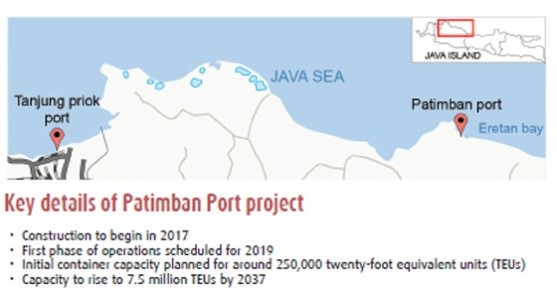Popular Reads
Top Results
Can't find what you're looking for?
View all search resultsPopular Reads
Top Results
Can't find what you're looking for?
View all search resultsPatimban vs. Tanjung Priok: A complementary competition between two giants
The Patimban Port, built on 370 hectares, has been designed to be the largest international seaport in Indonesia when its final stage of development is completed in 2027.
Change text size
Gift Premium Articles
to Anyone
P
hase one of the US$2.9 billion Patimban Port development project on the northern coast of West Java is scheduled to operate later this year with a container terminal able to handle 250,000 20-foot-equivalent units (TEU) and a car terminal to handle 218,000 built-up cars.
The Patimban Port, built on 370 hectares, has been designed to be the largest international seaport in Indonesia when its final stage of development is completed in 2027, with an annual capacity of more than 7 million TEUs of containers and 600,000 built-up cars. Right from the outset, the port has been designed to be a container and car terminal.
Patimban will compete with Jakarta’s international seaport of Tanjung Priok, which is also located on the northern coast of West Java. The question is then, what will be the role of the two giant seaports in Indonesia’s national logistics system?
West Java Governor Ridwan Kamil has planned an ambitious program to develop around Patimban Port a new large metropolitan area with 10 smart futuristic cities adopting 4.0 technology for more than 1 million inhabitants. Patimban has the advantage of being supported by several large manufacturing centers in Karawang and Bekasi.
The biggest supporter is certainly Japan-brand automotive manufacturer. No wonder, a big portion of the port project financing is provided by Japan. The cargo is there, and the connection between the port and the supporting industrial estates has been clearly defined from the beginning. Freight transportation from Karawang and Bekasi will be easy as they are connected with toll highways.
Tanjung Priok has been facing traffic congestion within Jakarta. At present, the port relies heavily on cargo supplies from industrial areas in Bekasi and Karawang, in West Java and from Tangerang on the west side of Jakarta in the Banten province. Tanjung Priok port expansion also has been hindered by a lack of development areas.
In the beginning, the capacity of Patimban will not be equal to Tanjung Priok’s. A quarter of a million containers is nothing compared to more than 7 million boxes handled by Tanjung Priok annually. However, cargo will continue to move to the east along with the increasing capacity of Patimban. It is good for the community and road users as they will enjoy a higher average driving speed. The traffic load will be partly distributed to the east and leave a relatively empty road to the west.
When Patimban comes into full-capacity operation, most industries in West Java will prefer to ship their products through this new port and this shift will deeply erode Tanjung Priok’s business volume.
The car terminal at Tanjung Priok is now the largest in the country, handling the export of 572,000 built-up cars in 2019. But when Patimban operates at full capacity, the Jakarta port will lose a big chunk of its cargo business.
In order to remain competitive, Tanjung Priok should diversify its business and move away from export and import trade as a transshipment port for other seaports in the Western part of Java.
Tanjung Priok has more facilities to run transshipment services and should rearrange the deployment of its terminals to accommodate such a role. Tanjung Priok could develop a good connection (data, vessels, operation) with feeder ports and use all connected terminals as a single yard. That connection will bring more potential container cargo.
Another game Tanjung Priok could play is the distribution of domestic containers, loaded with fast-moving consumer goods to supply the need of people in other islands. Domestic container shipments have taken a larger segment of sea transport across the vast archipelagic country.
Tanjung Priok should also expand its handling capacity of heavy equipment to offset the loss of its car-export handling business in the years to come.
***
The writer is a logistics and supply chain analyst. The views expressed are his own.










